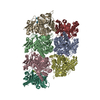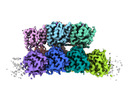+ Open data
Open data
- Basic information
Basic information
| Entry |  | |||||||||
|---|---|---|---|---|---|---|---|---|---|---|
| Title | Structure of activated SAVED-CHAT filament | |||||||||
 Map data Map data | ||||||||||
 Sample Sample |
| |||||||||
 Keywords Keywords | SAVED-CHAT / IMMUNE SYSTEM | |||||||||
| Function / homology | SMODS-associated and fused to various effectors / SMODS-associated and fused to various effectors sensor domain / CHAT domain / CHAT domain / CHAT domain-containing protein Function and homology information Function and homology information | |||||||||
| Biological species |  Haliangium ochraceum (bacteria) / synthetic construct (others) Haliangium ochraceum (bacteria) / synthetic construct (others) | |||||||||
| Method | single particle reconstruction / cryo EM / Resolution: 3.1 Å | |||||||||
 Authors Authors | Bravo JPK / Taylor DW | |||||||||
| Funding support |  United States, 2 items United States, 2 items
| |||||||||
 Citation Citation |  Journal: Science / Year: 2024 Journal: Science / Year: 2024Title: Type III-B CRISPR-Cas cascade of proteolytic cleavages. Authors: Jurre A Steens / Jack P K Bravo / Carl Raymund P Salazar / Caglar Yildiz / Afonso M Amieiro / Stephan Köstlbacher / Stijn H P Prinsen / Ane S Andres / Constantinos Patinios / Andreas Bardis ...Authors: Jurre A Steens / Jack P K Bravo / Carl Raymund P Salazar / Caglar Yildiz / Afonso M Amieiro / Stephan Köstlbacher / Stijn H P Prinsen / Ane S Andres / Constantinos Patinios / Andreas Bardis / Arjan Barendregt / Richard A Scheltema / Thijs J G Ettema / John van der Oost / David W Taylor / Raymond H J Staals /   Abstract: The generation of cyclic oligoadenylates and subsequent allosteric activation of proteins that carry sensory domains is a distinctive feature of type III CRISPR-Cas systems. In this work, we ...The generation of cyclic oligoadenylates and subsequent allosteric activation of proteins that carry sensory domains is a distinctive feature of type III CRISPR-Cas systems. In this work, we characterize a set of associated genes of a type III-B system from that contains two caspase-like proteases, SAVED-CHAT and PCaspase (prokaryotic caspase), co-opted from a cyclic oligonucleotide-based antiphage signaling system (CBASS). Cyclic tri-adenosine monophosphate (AMP)-induced oligomerization of SAVED-CHAT activates proteolytic activity of the CHAT domains, which specifically cleave and activate PCaspase. Subsequently, activated PCaspase cleaves a multitude of proteins, which results in a strong interference phenotype in vivo in Taken together, our findings reveal how a CRISPR-Cas-based detection of a target RNA triggers a cascade of caspase-associated proteolytic activities. | |||||||||
| History |
|
- Structure visualization
Structure visualization
| Supplemental images |
|---|
- Downloads & links
Downloads & links
-EMDB archive
| Map data |  emd_41358.map.gz emd_41358.map.gz | 256.4 MB |  EMDB map data format EMDB map data format | |
|---|---|---|---|---|
| Header (meta data) |  emd-41358-v30.xml emd-41358-v30.xml emd-41358.xml emd-41358.xml | 20.5 KB 20.5 KB | Display Display |  EMDB header EMDB header |
| Images |  emd_41358.png emd_41358.png | 89.7 KB | ||
| Masks |  emd_41358_msk_1.map emd_41358_msk_1.map | 512 MB |  Mask map Mask map | |
| Filedesc metadata |  emd-41358.cif.gz emd-41358.cif.gz | 6.3 KB | ||
| Others |  emd_41358_additional_1.map.gz emd_41358_additional_1.map.gz emd_41358_half_map_1.map.gz emd_41358_half_map_1.map.gz emd_41358_half_map_2.map.gz emd_41358_half_map_2.map.gz | 483.5 MB 474.4 MB 474.4 MB | ||
| Archive directory |  http://ftp.pdbj.org/pub/emdb/structures/EMD-41358 http://ftp.pdbj.org/pub/emdb/structures/EMD-41358 ftp://ftp.pdbj.org/pub/emdb/structures/EMD-41358 ftp://ftp.pdbj.org/pub/emdb/structures/EMD-41358 | HTTPS FTP |
-Validation report
| Summary document |  emd_41358_validation.pdf.gz emd_41358_validation.pdf.gz | 1.2 MB | Display |  EMDB validaton report EMDB validaton report |
|---|---|---|---|---|
| Full document |  emd_41358_full_validation.pdf.gz emd_41358_full_validation.pdf.gz | 1.2 MB | Display | |
| Data in XML |  emd_41358_validation.xml.gz emd_41358_validation.xml.gz | 19 KB | Display | |
| Data in CIF |  emd_41358_validation.cif.gz emd_41358_validation.cif.gz | 22.7 KB | Display | |
| Arichive directory |  https://ftp.pdbj.org/pub/emdb/validation_reports/EMD-41358 https://ftp.pdbj.org/pub/emdb/validation_reports/EMD-41358 ftp://ftp.pdbj.org/pub/emdb/validation_reports/EMD-41358 ftp://ftp.pdbj.org/pub/emdb/validation_reports/EMD-41358 | HTTPS FTP |
-Related structure data
| Related structure data |  8tl0MC M: atomic model generated by this map C: citing same article ( |
|---|---|
| Similar structure data | Similarity search - Function & homology  F&H Search F&H Search |
- Links
Links
| EMDB pages |  EMDB (EBI/PDBe) / EMDB (EBI/PDBe) /  EMDataResource EMDataResource |
|---|
- Map
Map
| File |  Download / File: emd_41358.map.gz / Format: CCP4 / Size: 512 MB / Type: IMAGE STORED AS FLOATING POINT NUMBER (4 BYTES) Download / File: emd_41358.map.gz / Format: CCP4 / Size: 512 MB / Type: IMAGE STORED AS FLOATING POINT NUMBER (4 BYTES) | ||||||||||||||||||||||||||||||||||||
|---|---|---|---|---|---|---|---|---|---|---|---|---|---|---|---|---|---|---|---|---|---|---|---|---|---|---|---|---|---|---|---|---|---|---|---|---|---|
| Projections & slices | Image control
Images are generated by Spider. | ||||||||||||||||||||||||||||||||||||
| Voxel size | X=Y=Z: 0.94 Å | ||||||||||||||||||||||||||||||||||||
| Density |
| ||||||||||||||||||||||||||||||||||||
| Symmetry | Space group: 1 | ||||||||||||||||||||||||||||||||||||
| Details | EMDB XML:
|
-Supplemental data
-Mask #1
| File |  emd_41358_msk_1.map emd_41358_msk_1.map | ||||||||||||
|---|---|---|---|---|---|---|---|---|---|---|---|---|---|
| Projections & Slices |
| ||||||||||||
| Density Histograms |
-Additional map: Sharpened map
| File | emd_41358_additional_1.map | ||||||||||||
|---|---|---|---|---|---|---|---|---|---|---|---|---|---|
| Annotation | Sharpened map | ||||||||||||
| Projections & Slices |
| ||||||||||||
| Density Histograms |
-Half map: #1
| File | emd_41358_half_map_1.map | ||||||||||||
|---|---|---|---|---|---|---|---|---|---|---|---|---|---|
| Projections & Slices |
| ||||||||||||
| Density Histograms |
-Half map: #2
| File | emd_41358_half_map_2.map | ||||||||||||
|---|---|---|---|---|---|---|---|---|---|---|---|---|---|
| Projections & Slices |
| ||||||||||||
| Density Histograms |
- Sample components
Sample components
-Entire : Active SAVED-CHAT filament
| Entire | Name: Active SAVED-CHAT filament |
|---|---|
| Components |
|
-Supramolecule #1: Active SAVED-CHAT filament
| Supramolecule | Name: Active SAVED-CHAT filament / type: complex / ID: 1 / Parent: 0 / Macromolecule list: all |
|---|---|
| Source (natural) | Organism:  Haliangium ochraceum (bacteria) Haliangium ochraceum (bacteria) |
| Molecular weight | Theoretical: 1.33 MDa |
-Macromolecule #1: CHAT domain-containing protein
| Macromolecule | Name: CHAT domain-containing protein / type: protein_or_peptide / ID: 1 / Number of copies: 7 / Enantiomer: LEVO |
|---|---|
| Source (natural) | Organism:  Haliangium ochraceum (bacteria) Haliangium ochraceum (bacteria) |
| Molecular weight | Theoretical: 54.378332 KDa |
| Recombinant expression | Organism:  |
| Sequence | String: IQCILVLDLS IDNAITACSV TPHLPRAARR VELHLNDFGA ERAPYGGASD RRTWRCWMQA VDAMLADARA QLGAEVEFTH YYLAGRAAL PVFAYLGLRL GKQANITTVN RRDDGCWDVV PCQRPASSAA SGVSPSARFF DEVRGLDTDE RSSESGMVAV W VSTQRDVD ...String: IQCILVLDLS IDNAITACSV TPHLPRAARR VELHLNDFGA ERAPYGGASD RRTWRCWMQA VDAMLADARA QLGAEVEFTH YYLAGRAAL PVFAYLGLRL GKQANITTVN RRDDGCWDVV PCQRPASSAA SGVSPSARFF DEVRGLDTDE RSSESGMVAV W VSTQRDVD RGLLRAFARA RGDRDLAGIV SLRARPAAGD DTGDMRLLEG ADGPDAAREL VNCFRSIPNQ YPRSSGLMVF VS GPVTLAA MVGRAINPRI HGPVWWPYFR GGEYEPALEY PWPLISGPPR ILIATANAPE GENPTLDVEA ELKHLEEALA EPR KRKLCE VQRCPAATVS DITSALRSFK PHILHFIGHG TALGVYLRSA EHDGAQFVRG EDFQQMIATS LRQKDREMHL VVLN ACCTH ELAKALTEQV SCTIGTDIEV YDSASIHFAA RFYDHLVHGT SVHYAFNAAV DECRAHSTSG QEVFCLHPAA ERAPA SATP PVRADELVFF SP UniProtKB: CHAT domain-containing protein |
-Macromolecule #2: RNA (5'-R(*AP*AP*A)-3')
| Macromolecule | Name: RNA (5'-R(*AP*AP*A)-3') / type: rna / ID: 2 / Number of copies: 7 |
|---|---|
| Source (natural) | Organism: synthetic construct (others) |
| Molecular weight | Theoretical: 942.66 Da |
| Sequence | String: AAA |
-Experimental details
-Structure determination
| Method | cryo EM |
|---|---|
 Processing Processing | single particle reconstruction |
| Aggregation state | particle |
- Sample preparation
Sample preparation
| Buffer | pH: 7.5 |
|---|---|
| Vitrification | Cryogen name: ETHANE |
- Electron microscopy
Electron microscopy
| Microscope | TFS GLACIOS |
|---|---|
| Image recording | Film or detector model: FEI FALCON IV (4k x 4k) / Average electron dose: 40.0 e/Å2 |
| Electron beam | Acceleration voltage: 200 kV / Electron source:  FIELD EMISSION GUN FIELD EMISSION GUN |
| Electron optics | Illumination mode: FLOOD BEAM / Imaging mode: BRIGHT FIELD / Nominal defocus max: 2.5 µm / Nominal defocus min: 1.5 µm |
 Movie
Movie Controller
Controller




 Z (Sec.)
Z (Sec.) Y (Row.)
Y (Row.) X (Col.)
X (Col.)




















































